| Srl | Item |
| 1 |
ID:
169394
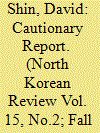

|
|
|
| 2 |
ID:
125267
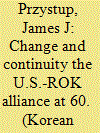

|
|
|
|
|
| Publication |
2013.
|
| Summary/Abstract |
It is important to recognize how successful the U.S.-ROK Alliance has been for the past sixty years in deterring North Korea from attempting to unify the Korean Peninsula by force. This paper addresses Korea's unique status and examines its strong presence in meeting commitments to the international community. The future will require alliance-based cooperation with international partners to address challenges posed by the proliferation of WMD, which is one among many. In the end, however, the U.S.-ROK Alliance will only grow stronger, enhancing stability and security on the Peninsula.
|
|
|
|
|
|
|
|
|
|
|
|
|
|
|
|
| 3 |
ID:
174732
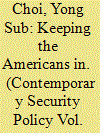

|
|
|
|
|
| Summary/Abstract |
Seoul and Washington have conceded that Terminal High Altitude Area Defense (THAAD) in South Korea cannot protect the capital region of Republic of Korea (ROK), including Seoul and Incheon, from North Korea’s missile attacks. Why did the South Korean government decide to deploy THAAD, risking possible retaliation from China, although it already knew its limited utility on the Korean peninsula? This article addresses the puzzle by connecting the deployment of THAAD in South Korea with the U.S. conception of a strategic rebalancing to Asia. By linking South Korea’s decision to deploy THAAD with contemporary alliance politics, extended deterrence, and abandonment and entrapment risks, it argues that Seoul’s THAAD decision was primarily intended to sustain and strengthen the U.S.-ROK alliance amid escalating nuclear threats by North Korea and deepening Sino-American rivalry.
|
|
|
|
|
|
|
|
|
|
|
|
|
|
|
|
| 4 |
ID:
193792
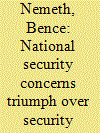

|
|
|
| 5 |
ID:
158630
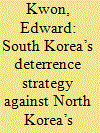

|
|
|
|
|
| Summary/Abstract |
This paper examines how South Korea might be able to deter the growing threat from North Korea’s nuclear weapons and missile programs. North Korea’s six nuclear weapons experiments with various types of missile test fires using solid fuel and new technology pose a security threat to South Korea and the USA. The credibility of the North’s WMD capability and the military balance of two Koreas are critically analyzed. South Korea’s superior conventional weapons system, supported by U.S. strategic weapons and intelligence systems, could fend off North Korean nuclear weapons and missile attacks. However, it is imperative that the U.S.-ROK alliance continues to develop a stringent nuclear deterrence strategy and deploy a series of countermeasures, including preemptive strikes and a multilayered missile defense system, such as Kill Chain, KAMD, and THAAD, all to guard against a potential nuclear weapon attack from North Korea.
|
|
|
|
|
|
|
|
|
|
|
|
|
|
|
|